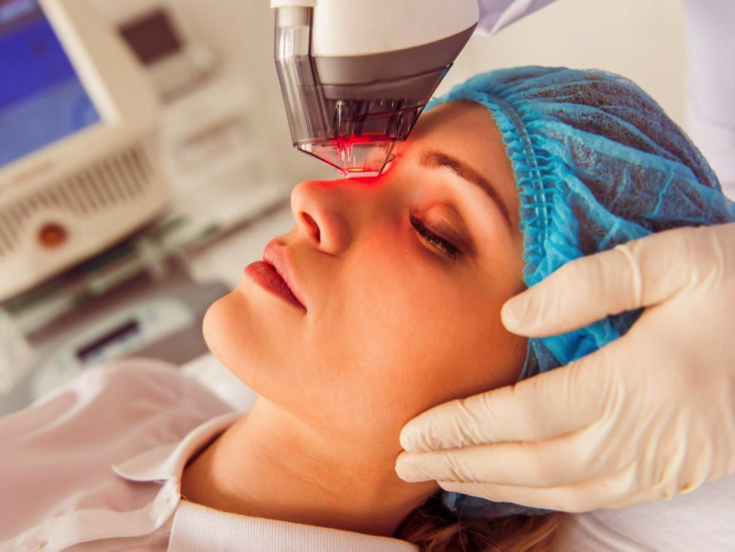In cosmetology practice, many procedures are used to rejuvenate the skin, which are based on certain physical processes. In this article, we will review the fractional photothermolysis procedure, which is carried out by exposing the skin to carbon dioxide laser. The method allows to achieve good stable results with a short rehabilitation period. Read further on estet-portal.com what the method consists of, what types of lasers are used for it, as well as indications and contraindications for the procedure.
- How Fractional Laser Photothermolysis Works on the Skin
- Indications and contraindications for the procedure. Types of photothermolysis
- Stages of photothermolysis. Skin care after treatment
How does laser fractional photothermolysis work on the skin
The fractional mode of operation of laser equipment is carried out by dividing the beam into small beams that are capable of penetrating into the deeper layers of the skin and damaging it pointwise. After the procedure, regeneration processesare activated on intact skin areas, elastin and collagen are synthesized, which is accompanied by a lifting- effect .
Thus, some separate areas of the skin are intentionally damaged in order to start the regeneration processes.
Clinical studies have made it clear that such a division of the laser beam into fractions during photothermolysis allows you to get the same result as with laser resurfacing. But with photothermolysis, the patient does not require long-term rehabilitation.
Read also: Electric current in cosmetology: main aspects of facial myostimulation
In darker people, photothermolysis does not damage melanocytes, so there are no spots with hypopigmentation after the procedure. At the same time, the melanin is redistributed, and, as a result, the color of the face is evened out.
Indications and contraindications for the procedure. Types of photothermolysis
With the help of photothermolysis, it is possible to solve many cosmetic defects and problems, as well as restore youth to the skin.
Indications for Fractional Photothermolysis:
- post-acne;
- enlarged pores;
- scars and scars;
- stretch marks;
- small wrinkles in the eyelid area;
- aging skin changes;
- presence of deep wrinkles:
- presence of hypopigmentation, spots and other pigmentation disorders.
Contraindications for the photothermolysis procedure:
- oncological process;
- acute infectious processes;
- exacerbation of chronic processes;
- pregnancy and lactation;
- epilepsy;
- disturbances in blood clotting processes;
- acute psoriasis;
- inflammation, dermatitis, moles and warts in the treatment area;
- renal failure;
- hepatitis C and B, HIV;
- long-term use of cytostatics, anticoagulants, glucocorticosteroids or antibiotics.
Read more of our content on Facebook!
Fractional photothermolysis exists in 2 types - ablative and non-ablative.
- Ablative photothermolysis is performed using a CO2 laser whose beam damages the dermis in its deep layers. Coagulation and destruction of proteins in the superficial layers of the skin occur. Within 3 months, new collagen is formed in the area of action.
This photothermolysis is used to eliminate scars, deep wrinkles, sagging skin, age spots, scars and scars.
- Non-ablative photothermolysis is used to improve the appearance of the face, eyelids, neck, as well as to eliminate post-acne and stretch marks. This type of photothermolysis is not accompanied by damage to the dermis, the erbium laser beams penetrate under the epidermis and do not damage it.
More often this type of photothermolysis is used to eliminate age spots, as melanin is redistributed. The effect of non-ablative photothermolysis is prolonged.
Stages of photothermolysis. Skin care after treatment
10 days before the photothermolysis session, it is important to do not peel or scrub, stop using products that contain salicylic acid, retinol and glycoic acid.
The skin is cleaned, a local anesthetic is applied, then the skin is covered with an ointment to better glide the device nozzle over the skin. Procedure painless. The average time for one session is 30-40 minutes. At the end of the procedure, a cream with soothing properties is applied to the skin.

Primary result is noticeable after 5 days. Patients note the alignment of facial tone, increased skin elasticity. The process of skin rejuvenation lasts for another 3 months. The result pleases patients for several years.
After the photothermolysis procedure, the skin requires special care for some time.
Skin care after photothermolysis:
- Photothermolysis on the body involves the further wearing of compression underwear;
- use restorative masks, use creams with panthenol;
- moisturize the skin 2-3 times a day;
- when crusts appear, do not remove them;
- Do not overheat the treatment area for the first 2 weeks. Refuse from solariums, baths and saunas;
- treat the skin with recommended preparations;
- do not use scrubs, do not peel.
You will also be interested in: Microcurrent therapy: indications, effectiveness, basics of the technique
It is important to follow the rules for handling the skin after photothermolysis to prevent complications. Complications can be: swelling, dark skin tone, dryness, peeling, skin hyperemia, inflammation in the treatment area, hyperpigmentation, scars. Therefore, it is important to properly care for the skin after photothermolysis, as well as to carry out the procedure with an experienced cosmetologist.
Watch our videos on YouTube-channel!







Add a comment